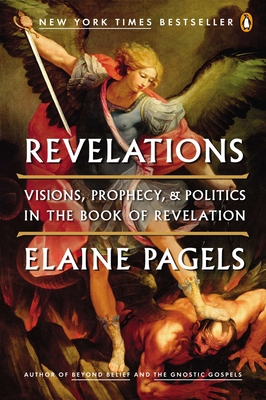A startling exploration of the history of the most controversial book of the Bible, by the bestselling author of Beyond Belief.
Through the bestselling books of Elaine Pagels, thousands of readers have come to know and treasure the suppressed biblical texts known as the Gnostic Gospels. As one of the world's foremost religion scholars, she has been a pioneer in interpreting these books and illuminating their place in the early history of Christianity. Her new book, however, tackles a text that is firmly, dramatically within the New Testament canon: The Book of Revelation, the surreal apocalyptic vision of the end of the world . . . or is it?
In this startling and timely book, Pagels returns The Book of Revelation to its historical origin, written as its author John of Patmos took aim at the Roman Empire after what is now known as "the Jewish War," in 66 CE. Militant Jews in Jerusalem, fired with religious fervor, waged an all-out war against Rome's occupation of Judea and their defeat resulted in the desecration of Jerusalem and its Great Temple. Pagels persuasively interprets Revelation as a scathing attack on the decadence of Rome. Soon after, however, a new sect known as "Christians" seized on John's text as a weapon against heresy and infidels of all kinds-Jews, even Christians who dissented from their increasingly rigid doctrines and hierarchies.
In a time when global religious violence surges, Revelations explores how often those in power throughout history have sought to force "God's enemies" to submit or be killed. It is sure to appeal to Pagels's committed readers and bring her a whole new audience who want to understand the roots of dissent, violence, and division in the world's religions, and to appreciate the lasting appeal of this extraordinary text.
Christianity was born nearly two thousand years ago in ancient Palestine. It has shaped the course of human history. Yet historians still cannot say how it really began. How did a first-century Jew called Jesus manage to spark a new religion?
It is one of the biggest and most profound of all historical mysteries. This extraordinary book finally provides a convincing answer.
Traditionally, the birth of Christianity has been explained via the miracle of the Resurrection. After Jesus died he was raised from the dead by God and appeared to his disciples, telling them to spread the gospel. Once they saw the Risen Jesus, nothing could shake their belief. Within a few generations Christianity had spread throughout the Middle East and Europe; within a few centuries it had taken over much of the world.
But historians have been unable to account for Christianity’s remarkable success without the Resurrection to spark it. If no one really saw the Risen Jesus, how were his followers convinced that he was their immortal Messiah?
Art historian Thomas de Wesselow has spent the last seven years deducing the answer to this puzzle, and in doing so he has pieced together an entirely new picture of the birth of Christianity. Reassessing a familiar but misunderstood historical source and reinterpreting many biblical passages, de Wesselow shows that the solution has been staring us in the face for more than a century.
The Shroud of Turin, widely thought to be a fake, is in fact authentic. And it holds the key to the greatest mystery in human history.


No comments:
Post a Comment